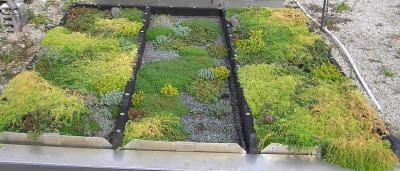Sep 7 2009
One way to maximize the eco-friendly factor of a structure is to include a green roof—and this doesn't refer to the paint color. "Greening" a roof, or covering a roof with vegetation, is gaining popularity in North America, where the number of green roofs increased 30% from 2006 to 2007. Benefits of green roofs include improved storm water management, energy conservation, reduced noise and air pollution, improved biodiversity, and even a better return on investment than traditional roofing.
 This photo shows roof platforms showing different plot depths. The difference in plant growth between the three media depths is visible. Credit: Photo by Kristin Getter
This photo shows roof platforms showing different plot depths. The difference in plant growth between the three media depths is visible. Credit: Photo by Kristin Getter
But a healthy roof requires the selection of a species that can survive extreme climates and propagate easily to reduce erosion and weed growth. Kristin L. Getter of Michigan State University's Department of Horticulture led a study to determine the effect of the growing medium's depth on the success of green roofs. The research study, published in a recent issue of HortScience, focused on Sedum, a variety of succulent known for its drought tolerance.
Plots were constructed using the drainage mats and waterproofing systems typical of green roofs, but the growing material varied in depth from 4 cm, 7 cm, and 10 cm. Twelve species of Sedum were planted, fertilized, and watered once. The moisture of the growing material was measured at random times each week. Measurements of chlorophyll fluorescence were taken to monitor the health of the plants during a variety of environmental conditions.
Plants were monitored over the course of four years. Since the average lifespan of the inorganic components of a green roof is about 45 years, the researchers determined that it was important to study the longevity of the plants. The study found that the shallowest plot had the lowest moisture levels on average and dried the fastest after a rain. At the 4-cm depth, four species failed to exhibit significant growth over the 4-year period.
Five species showed no or little growth at the 7-cm depth, and six species showed no or little growth at a depth of 10 cm. Some species declined over the 4-year period at the varying depths. The remaining plants that flourished were the same species for all three depths (S. floriferum, S. sexangulare, S. spurium 'John Creech', and S. stefco). The 4-cm depth also included two other species (S. hispanicum and S. reflexum 'Blue Spruce').
Furthermore, the results indicate that, for the surviving and most-abundant species, there is no benefit to depths greater than 7 cm, which would appear to be good news considering shallow depths are more desirable because they make for lighter roof loads. "However, at deeper depths, these plants would likely be healthier, contain greater biomass, and be less susceptible to adverse environmental conditions. This study shows the importance of growing medium depth for plant performance and demonstrates the need for long-term evaluation of species for use in this green practice", concluded the researchers.